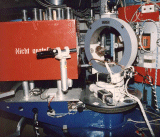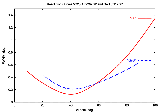 Photo of the spectrometer
Photo of the spectrometer
| Beam tube | 5C2 (hot source) |
| Type of instrument | Centric Eulerian cradle (Stoe) |
| Angular range | -100° < 2theta < 130°
-60° < omega < 65° -180° < chi < 180° -180° < phi < 180° |
| Monochromators | Cu(220) and Ge1-xSix(311), adjustable vertical focussing |
| Incident wavelength | 0.830 Å, (Cu 220), Erbium filter or 1.106 Å, Ge1-xSix(311) |
| Max. beamsize at specimen | 15 mm |
| Max. flux at specimen (n cm-2 s-1) | 4.5 x 106 (lambda = 0.830 Å, alpha1 = 58')
4.5 x 106 (lambda = 1.106 Å, alpha1 = 58') |
| lambda/2 contamination | < 0.1 % for lambda = 0.830 Å, none for lambda = 1.106 Å |
| Primary collimation alpha1 | 58', 28' or 14' |
| Max. resolution for alpha1 = 58' | d(omega) = 0.12° (FWHM) at 2theta = 40° for lambda = 0.830
Å
d(omega) = 0.20° (FWHM) at 2theta = 40° for lambda = 1.106 Å |
| Detectors | 3He or BF3 detectors, position sensitive detector under construction |
| Data collection and instrument control system | PC (LINUX), modified and extended DIF4N software |
| Ancillary equipment | cryostat and furnace
(5 K < T < 1400 K) |
The purpose of this four-circle diffractometer is the measurement of Bragg-reflections for the evaluation of structure factors. It allows to determine crystal structures and magnetic structures of twinned or untwinned single crystals. Typical applications are the localisation of hydrogen in inorganic and organic compounds, the analysis of disordered crystal structures and anharmonic displacement parameters, structural phase transitions, magnetic structures, high-Tc superconductors or related materials, and quasicrystals. The shorter wavelength is used to study small unit cells (V < 2000 Å3) up to high (sin theta)/lambda, which allows to obtain very precise information on thermal displacement parameters. The longer wavelength is used to collect data of even larger unit cells (V < 8000 Å3) with a high resolution.
A helium cryostat and a furnace allow temperature dependent structure investigations in the temperature range from 5 K to 300 K and from 300 K to 1400 K. Special sample environments (like uniaxial or hydrostatic pressure, electric or magnetic fields) can be adapted individually.
This diffractometer (named P110) was built by german scientists in cooperation of the FZ Karlsruhe and the LLB. It is currently operated by the RWTH Aachen and the LLB under the „Verbundforschung“ program of the Federal Ministry of Education and Research „BMBF“.
 Setup
of the diffractometer
Setup
of the diffractometer
 Resolution
of the diffractometer
Resolution
of the diffractometer
e-mail : 5c2@llb.saclay.cea.fr